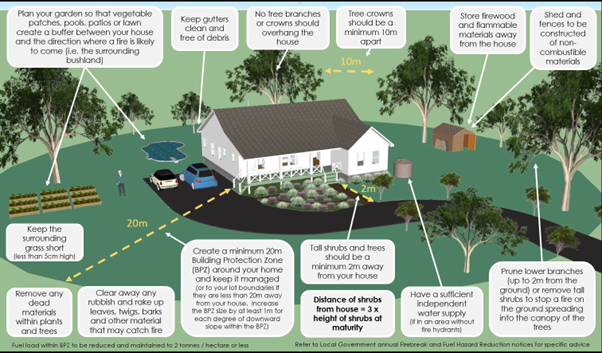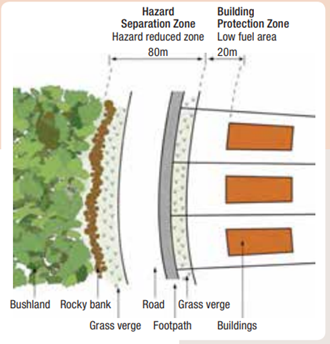Firewise Gardening

Options for plant selection and garden design for fire prone areas
Did you know that planting the right plants – called firewise planting – can help to protect you in a bushfire prone area?
With climate change increasing the risk of fires, it’s important to be fire-resilient. One of the best ways to protect your property is by incorporating firewise principles into your landscaping.
Remember, while all plants can burn, some burn faster and hotter than others. Choosing firewise plants, using firewise garden design, and following firewise maintenance can make all the difference.
First things first – what you have to do
Planning and managing a property in a bushfire prone area has to follow principles from State and local government policies, which recognise the potential for firewise planting.
State Planning Policy 3.7 – Planning in Bushfire Prone Areas directs how land use should address bushfire risk management. A set of guidelines advise on how bushfire risk is to be addressed in planning and design in a bushfire prone area.
At a local level, landholders must comply with the Fire Hazard Reduction Notice, including installing firebreaks and maintaining an Asset Protection Zone.
The Asset Protection Zone
An Asset Protection Zone (AZP) is an area surrounding a building that is managed to reduce the bushfire hazard to an acceptable level. This means maintaining a fuel-reduced zone around all buildings which extends 20m from the outermost point of the building. Minimum standards for maintenance of the APZ include:
- Gutters, roofs, and walls of all buildings to be free of flammable matter and maintained.
- Fuel load within the 20m zone is reduced and maintained to no more than 2 tonne per hectare.
- Trees over 5m in height within the 20m zone to be under pruned up to 2m.
- Trees or shrubs within 2m of the asset shall be pruned to a height no greater than 2m and/or pruned away from the asset to a distance no greater than 2m.

Firewise terminology
Using different terms gives a different impression of plants and landscaping. Firewise plants have been identified and selected based on their flammability, and linked to maintenance advice and planting location.
Sometimes plants are called Fireproof, which gives the misleading impression that the plant will not burn. A Fire Resistant plant will survive being burnt and will regrow after fire, but may be highly flammable and inappropriate for a bushfire prone area. A Fire Retardant plant may not burn readily or may slow the passage of a bushfire, but may not necessarily be suitable for planting in a bushfire prone area.
Whatever term you choose to use should be based on the plant’s flammability – all plants burn but some burn slower and cooler than others and are more desirable in fire prone areas.

So what makes a plant firewise?
There are certain characteristics that make a plant more or less flammable, such as moisture or oil content and the type of bark. Plants with lower flammability properties may still burn during a bushfire, but may be more resistant to burning and some may regenerate faster after the fire.
Features of plants more likely to burn (and to be avoided in fire prone areas) include:
- Fibrous, loose bark (e.g. stringybarks)
- Volatile oils in their leaves (anything with a strong scent when crushed)
- Volatile, resinous foliage (e.g. conifers and grasstrees)
- Dry foliage (e.g. annual grasses)
- Retained or accumulated dead leaves and twigs
- Fine, narrow foliage
- Open, airy crowns
- Larger size
- Planted in clumps or dense rows
Features of plants less likely to burn (and suitable for fire prone areas) include:
- Smooth bark
- High levels of moisture in leaves (e.g. succulents)
- High levels of salt in leaves (e.g. saltbush)
- Do not retain dead material
- Broad, fleshy leaves
- Dense foliage
- Smaller size
- Planted with separation between plants
- Irrigation makes a big difference to flammability
So how should you select plants for a fire prone area?
- Choose plants with smooth bark rather than rough bark
- Choose plants that do not accumulate dead materials
- Avoid plants with a strong smell when crushed – these will contain volatile oils and include:
- Eucalypts, melaleucas, bottlebrushes etc.
- Conifers and pines
- Grasstrees
- Some herbs such as rosemary and lavender
- Some citrus trees
- Choose plants with high moisture or salt content
- Remove dead materials and irrigate where possible

Maintenance is essential
Proper maintenance of your garden is essential and can’t be separated from plant selection. Lower flammability vegetation along with ongoing maintenance and careful placement and design is critical to firewise landscaping.
So what maintenance does a firewise garden need?
- All plants will burn, some just burn faster and hotter than others
- Dry and dead material provides fuel for fires
- Prune plants to remove dead branches and materials
- Remove leaf litter and fallen branches
- Consider replacing organic mulch with inorganic (e.g. gravel) or low flammability groundcover plants
- Irrigate within the BPZ (first 20m)
- Design to place pools, patios, irrigated lawns, vegetable gardens on the side most at risk to bushfire

Firewise garden design
How you design your garden, place your plants and what materials you include around them is just as important as the choice of plants.
In the Building Protection Zone (the first 20m around your house), you should:
- Manage and reduce fuel loads
- Maintain separation of tree crowns at least 10m apart,
- Prune taller trees so that the lowest branches are 2m from the ground
- Trees must be at least 2m from buildings
- Shrubs should be separated from buildings by at least three times their mature height
- Remove dead material and leaf litter
- Irrigate where possible
- Choose firewise plants
In the Hazard Separation Zone (the next 80m after the BPZ), you should:
- Engage in hazard reduction
- Reduce and manage fuel loads
- Space plants with non-flammable materials in between
- Select firewise plants
- Plant firewise windbreaks
Fuels should be minimal in the BPZ, but more planting is appropriate in the HSZ. Both zones must be contained within your property, but can include features such as roads. Creation of these zones is highly damaging to natural, remnant vegetation however, so professional advice should be sought to minimise damage to the environment.


Windbreaks as fire shelter belts
A barrier of low flammability trees, shrubs and ground cover plants can:
- Screen radiant heat and absorb (some) heat without burning
- Reduce wind speed and trap embers and sparks
- Catch burning embers without catching fire
- Slow the travel of a fire along the ground
A fire shelter belt should be located at least 30m from the house, in the HSZ, on the side where fires are most likely to approach (consider slope, prevailing winds and vegetation).
The tree layer is commonly recommended to be deciduous trees (but remember to clean up leaf litter!). If you are under-pruning your trees to 2m from the ground (as is recommended), embers and sparks can still pass under the trees. A second belt of shrubs and groundcovers to catch the low-flying embers and sparks can be considered, but should be spaced far enough from the trees to avoid carrying fire into the tree crowns if the shrubs catch fire.

What are some firewise plants?
Examples of firewise trees include:
- Acacia
- Banksia, grevillea, hakea
- Eremophila
- Some casuarinas, particularly swamp sheoak ( obesa)
- Most deciduous trees and fruit trees
- Many other native and non-native trees are low flammability
- All groups will have higher flammability exceptions
Firewise shrubs include:
- Acacia
- Banksia, grevillea, hakea
- Eremophila
- Salt bush (including Rhagodia and Atriplex)
- Pea flowered natives
- Many other native and non-native shrubs are low flammability
- All groups will have higher flammability exceptions
Some firewise ground cover plants are:
- Kangaroo paws, lomandra, patersonia
- Salt bush and succulents (e.g. pigface)
- Dichondra, prostrate hibbertia
- Pea flowered natives (e.g. kennedia)
- Many other native and non-native ground covers are low flammability
- All groups will have higher flammability exceptions
Further information
There is a great deal of information on firewise planting and landscaping on the internet, of variable quality and relevance. Some useful pages include:
Watch our educational video below: